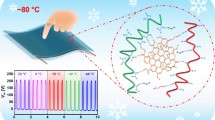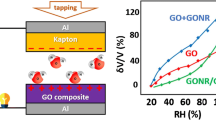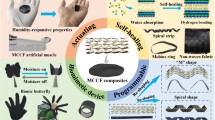Abstract
Actuators that can directly convert other forms of environmental energy into mechanical work offer great application prospects in intriguing energy applications and smart devices. But to-date, low cohesion strength of the interface and humidity responsive actuators primarily limit their applications. Herein, by experimentally optimizing interface of bimorph structure, we build graphene oxide/ethyl cellulose bidirectional bending actuators—a case of bimorphs with fast and reversible shape changes in response to environmental humidity gradients. Meanwhile, we employ the actuator as the engine to drive piezoelectric detector. In this case, graphene oxide and ethyl cellulose are combined with chemical bonds, successfully building a bimorph with binary synergy strengthening and toughening. The excellent hygroscopicity of graphene oxide accompanied with huge volume expansion triggers giant moisture responsiveness greater than 90 degrees. Moreover, the open circuit voltage of piezoelectric detector holds a peak value around 0.1 V and exhibits excellent reversibility. We anticipate that humidity-responsive actuator and detector hold promise for the application and expansion of smart devices in varieties of multifunctional nanosystems.
摘要
致动器可以将外界环境中的能量直接转换成机械能, 在能源应用和智能设备上有着广阔的应用前景. 但迄今为止, 界面接触强度较低以及湿度响应是制约驱动器发展的瓶颈问题, 限制了其实际应用. 本文从实验上构建了优化双层膜结构驱动器界面接触的模型, 所构建的氧化石墨烯与乙基纤维素双层膜致动器对于环境湿度的变化具有快速可逆的响应性, 同时可以驱动压电探测器. 此结构模型中, 氧化石墨烯与乙基纤维素之间通过化学键结合, 成功地构建了机械强度和韧性协同增强的双层膜驱动器. 由于氧化石墨烯的优异吸湿特性, 同时伴随着明显的体积膨胀, 引起双层膜驱动器对于湿度变化超过90度弯曲的响应. 同时, 构建的压电传感器具有优异可逆性的0.1 V开路电压. 我们期望湿度响应驱动器和传感器有望在各种多功能纳米系统中得到应用并能服务于智能设备领域.
Similar content being viewed by others
References
Lencka MM, Riman RE. Intelligent synthesis of smart ceramic materials. Encyclopedia of Smart Materials, Heidelberg: John Wiley and Sons, Inc., 2002
Wang L, Luo ZB, Xia ZX, et al. Review of actuators for high speed active flow control. Sci China Technol Sci, 2012, 55: 2225–2240
Wong YS, Kong JF, Widjaja LK, et al. Biomedical applications of shape-memory polymers: how practically useful are they? Sci China Chem, 2014, 57: 476–489
Zhao Y, Song L, Zhang Z, et al. Stimulus-responsive graphene systems towards actuator applications. Energy Environ Sci, 2013, 6: 3520
Hu Y, Wu G, Lan T, et al. A graphene-based bimorph structure for design of high performance photoactuators. Adv Mater, 2015, 27: 7867–7873
Kong L, Chen W. Carbon nanotube and graphene-based bioinspired electrochemical actuators. Adv Mater, 2014, 26: 1025–1043
Cheng H, Liu J, Zhao Y, et al. Graphene fibers with predetermined deformation as moisture-triggered actuators and robots. Angew Chem Int Ed, 2013, 52: 10482–10486
Lan T, Hu Y, Wu G, et al. Wavelength-selective and reboundable bimorph photoactuator driven by a dynamic mass transport process. J Mater Chem C, 2015, 3: 1888–1892
Dong L, Yang J, Chhowalla M, et al. Synthesis and reduction of large sized graphene oxide sheets. Chem Soc Rev, 2017, 46: 7306–7316
Liao L, Peng H, Liu Z. Chemistry makes graphene beyond graphene. J Am Chem Soc, 2014, 136: 12194–12200
Qin J, Zhou F, Xiao H, et al. Mesoporous polypyrrole-based graphene nanosheets anchoring redox polyoxometalate for all-solidstate micro-supercapacitors with enhanced volumetric capacitance. Sci China Mater, 2018, 61: 233–242
Jian M, Wang C, Wang Q, et al. Advanced carbon materials for flexible and wearable sensors. Sci China Mater, 2017, 60: 1026–1062
Li X, Jiang T, Wang X, et al. Superhydrophobic graphene-decorated mesh gauze: recycling oils and organic solvents enhanced by large-diameter capillary action. Sci China Mater, 2016, 59: 581–588
Han DD, Zhang YL, Jiang HB, et al. Moisture-responsive graphene paper prepared by self-controlled photoreduction. Adv Mater, 2015, 27: 332–338
Park S, An J, Suk JW, et al. Graphene-based actuators. Small, 2010, 6: 210–212
Han DD, Zhang YL, Liu Y, et al. Bioinspired graphene actuators prepared by unilateral UV irradiation of graphene oxide papers. Adv Funct Mater, 2015, 25: 4548–4557
Wu C, Feng J, Peng L, et al. Large-area graphene realizing ultrasensitive photothermal actuator with high transparency: new prototype robotic motions under infrared-light stimuli. J Mater Chem, 2011, 21: 18584
Xu G, Zhang M, Zhou Q, et al. A small graphene oxide sheet/ polyvinylidene fluoride bilayer actuator with large and rapid responses to multiple stimuli. Nanoscale, 2017, 9: 17465–17470
Guo F, Kim F, Han TH, et al. Hydration-responsive folding and unfolding in graphene oxide liquid crystal phases. ACS Nano, 2011, 5: 8019–8025
Marcano DC, Kosynkin DV, Berlin JM, et al. Improved synthesis of graphene oxide. ACS Nano, 2010, 4: 4806–4814
Chen K, Shi B, Yue Y, et al. Binary synergy strengthening and toughening of bio-inspired nacre-like graphene oxide/sodium alginate composite paper. ACS Nano, 2015, 9: 8165–8175
Pan S, Liu X. CdS–graphene nanocomposite: synthesis, adsorption kinetics and high photocatalytic performance under visible light irradiation. New J Chem, 2012, 36: 1781–1787
Eberhardt ES, Panisik N, Raines RT. Inductive effects on the energetics of prolyl peptide bond isomerization: implications for collagen folding and stability. J Am Chem Soc, 1996, 118: 12261–12266
Holmgren SK, Bretscher LE, Taylor KM, et al. A hyperstable collagen mimic. Chem Biol, 1999, 6: 63–70
Ganguly A, Sharma S, Papakonstantinou P, et al. Probing the thermal deoxygenation of graphene oxide using high-resolution in situ X-ray-based spectroscopies. J Phys Chem C, 2011, 115: 17009–17019
Park S, Lee KS, Bozoklu G, et al. Graphene oxide papers modified by divalent ions—enhancing mechanical propertiesvia chemical cross-linking. ACS Nano, 2008, 2: 572–578
Lv XJ, Yao MS, Wang GE, et al. A new 3D cupric coordination polymer as chemiresistor humidity sensor: narrow hysteresis, high sensitivity, fast response and recovery. Sci China Chem, 2017, 60: 1197–1204
Acknowledgements
This work was financially supported by the National Basic Research Program of China (2015CB932302), National Natural Science Foundation of China (U1432133, 11621063, 21701164), National Program for Support of Top-notch Young Professionals and the Fundamental Research Funds for the Central Universities (WK2060190084, WK2060190058). We would like to thank the Catalysis and Surface Science Endstation (National Synchrotron Radiation Laboratory) for providing the beam time. This work was also supported from the Major/Innovative Program of Development Foundation of Hefei Center for Physical Science and Technology.
Author information
Authors and Affiliations
Corresponding author
Additional information
Bo Yang received his BS (2013) and MEng (2016) degrees from School of Physics and Materials Science, Anhui University. He is currently pursuing his PhD under the supervision of Prof. Changzheng Wu and Prof. Linghui He at University of Science and Technology of China (USTC). His research focuses on the design and exploration of smart materials.
Changzheng Wu obtained his BS (2002) and PhD (2007) degrees from the Department of Chemistry, USTC. Thereafter, he has been working as a postdoctoral fellow in the Hefei National Laboratory for Physical Sciences at Microscale. He is now a full professor of Department of Chemistry, USTC. His current research focuses on the synthesis and characterization of inorganic two-dimensional nanomaterials and regulation of their intrinsic physical properties for a wide range of applications in energy storage or energy conversion.
Electronic supplementary material
Rights and permissions
About this article
Cite this article
Yang, B., Bi, W., Zhong, C. et al. Moisture-triggered actuator and detector with high-performance: interface engineering of graphene oxide/ethyl cellulose. Sci. China Mater. 61, 1291–1296 (2018). https://doi.org/10.1007/s40843-018-9249-y
Received:
Accepted:
Published:
Issue Date:
DOI: https://doi.org/10.1007/s40843-018-9249-y




